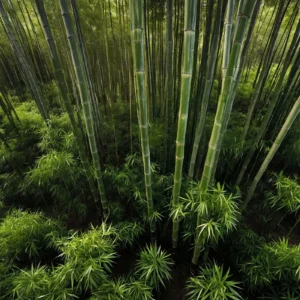Bamboo, a symbol of strength and resilience, has been a vital part of construction and design for centuries, especially in Asian cultures. The unique combination of its aesthetic appeal and environmental sustainability has made it a favorite among architects and designers around the globe. One of the most remarkable applications of this versatile material is in the construction of bamboo villas. These structures are not only architectural marvels but also represent a harmonious blend of nature and modern living. In this article, we will delve into the beauty of bamboo villas, exploring design inspirations and architectural wonders that make them stand out.
The Appeal of Bamboo in Architecture
1. Sustainability and Eco-Friendliness
Bamboo is one of the fastest-growing plants in the world, making it a highly renewable resource. It can grow up to three feet in a day and reaches maturity in three to five years, compared to traditional hardwoods that can take decades to mature. This rapid growth rate means that bamboo forests can be harvested sustainably without causing deforestation. Moreover, bamboo releases 35% more oxygen into the atmosphere than an equivalent stand of trees, contributing positively to the environment.
2. Strength and Durability
Despite its lightweight nature, bamboo is incredibly strong. It has a higher tensile strength than many types of steel, making it an excellent material for construction. Its flexibility allows it to withstand natural calamities such as earthquakes and strong winds, which is why it has been used in regions prone to such events. When treated properly, bamboo can also resist pests and rot, ensuring the longevity of the structures.
3. Aesthetic Versatility
Bamboo’s natural look brings a touch of elegance and tranquility to any space. Its texture and color can be incorporated into various design styles, from rustic to contemporary. The versatility of bamboo allows for creative freedom in architectural design, enabling architects to create unique and visually stunning structures.
Design Inspirations from Bamboo Villas
1. Traditional Meets Modern
One of the most inspiring aspects of bamboo villas is the seamless integration of traditional design elements with modern architecture. Many bamboo villas incorporate traditional thatched roofs and open floor plans that promote natural ventilation and lighting. These elements are combined with modern amenities and sleek designs to create a perfect blend of old and new.
2. Open-Air Living
Bamboo villas often feature open-air living spaces that allow residents to connect with nature. Large verandas, open kitchens, and expansive living areas are common, providing a sense of freedom and relaxation. This design not only enhances the aesthetic appeal but also promotes sustainability by reducing the need for artificial lighting and air conditioning.
3. Organic Shapes and Curves
Bamboo’s flexibility allows architects to experiment with organic shapes and curves that are difficult to achieve with conventional building materials. Many bamboo villas boast stunning curved roofs, spiral staircases, and flowing lines that mimic the natural environment. These organic shapes create a harmonious balance between the built environment and nature, enhancing the overall appeal of the villas.
4. Eco-Friendly Interiors
The use of bamboo is not limited to the structure of the villa; it extends to the interiors as well. Bamboo furniture, flooring, and decorative elements are popular choices for creating a cohesive and eco-friendly design. The natural texture and color of bamboo add warmth and character to the interiors, making the living spaces inviting and comfortable.
Architectural Wonders: Notable Bamboo Villas Around the World
1. Green Village, Bali, Indonesia
Green Village in Bali is a prime example of how bamboo can be used to create luxurious and sustainable living spaces. Designed by Ibuku, a Bali-based architecture firm, the village consists of several bamboo villas set along the Ayung River. Each villa is uniquely designed, showcasing the versatility and beauty of bamboo. The structures feature open-air living spaces, intricate bamboo craftsmanship, and eco-friendly amenities, making them a perfect blend of luxury and sustainability.
2. The Six Senses Con Dao, Vietnam
The Six Senses Con Dao is a luxury resort in Vietnam that features stunning bamboo villas. The resort’s design emphasizes sustainability and harmony with nature, using locally sourced bamboo and other natural materials. The villas offer breathtaking views of the ocean and surrounding landscape, with open-air living spaces and eco-friendly interiors. The resort’s commitment to sustainability extends to its operations, making it a model for eco-friendly luxury.
3. The Alila Villas Uluwatu, Bali, Indonesia
Located on a clifftop overlooking the Indian Ocean, the Alila Villas Uluwatu in Bali are a testament to the beauty and versatility of bamboo. Designed by Singapore-based WOHA Architects, the villas feature open-plan living spaces, bamboo screens, and eco-friendly materials. The design emphasizes sustainability and harmony with the natural environment, creating a serene and luxurious retreat.
4. Bamboo House, Costa Rica
The Bamboo House in Costa Rica is an architectural marvel that showcases the potential of bamboo in sustainable design. Designed by Benjamin Garcia Saxe, the house features an open-plan layout, large windows, and bamboo interiors. The structure is elevated on stilts to minimize its impact on the landscape, and the use of bamboo and other natural materials creates a harmonious connection with the surrounding environment.
5. The Green School, Bali, Indonesia
While not a villa, the Green School in Bali deserves mention for its innovative use of bamboo in architecture. Designed by John Hardy, the school is built entirely from bamboo and other sustainable materials. The open-air classrooms, bamboo bridges, and organic shapes create a unique and inspiring learning environment. The Green School is a testament to the potential of bamboo in creating sustainable and beautiful structures.
The Future of Bamboo Architecture
1. Innovations in Bamboo Treatment and Construction
Advancements in bamboo treatment and construction techniques are expanding the possibilities for bamboo architecture. New methods of treating bamboo to enhance its durability and resistance to pests are being developed, making it an even more viable option for construction. Additionally, innovative construction techniques such as prefabrication and modular design are making it easier and more cost-effective to build with bamboo.
2. Integration with Modern Technology
The integration of modern technology with bamboo construction is opening up new possibilities for sustainable living. Smart home technology, renewable energy systems, and advanced building materials can be seamlessly integrated with bamboo structures, creating homes that are both eco-friendly and technologically advanced. This combination of traditional materials and modern technology represents the future of sustainable architecture.
3. Growing Popularity and Demand
As awareness of environmental issues continues to grow, so does the demand for sustainable and eco-friendly housing options. Bamboo villas are becoming increasingly popular among environmentally conscious consumers who appreciate the combination of luxury and sustainability. This growing demand is driving innovation and investment in bamboo construction, ensuring that it will play a significant role in the future of architecture.
4. Community and Social Impact
Bamboo architecture is not only beneficial for the environment but also for local communities. The use of bamboo in construction supports local economies by providing jobs and promoting the sustainable management of bamboo forests. Additionally, bamboo structures are often more affordable than traditional buildings, making them an accessible option for low-income communities. By promoting bamboo architecture, we can create positive social and economic impacts while protecting the environment.
Conclusion
Bamboo villas represent a perfect blend of beauty, sustainability, and innovation. Their unique design inspirations and architectural wonders showcase the incredible potential of bamboo as a building material. As we move towards a more sustainable future, bamboo architecture offers a viable and attractive solution for creating eco-friendly and luxurious living spaces. Whether it’s the stunning Green Village in Bali or the innovative Bamboo House in Costa Rica, bamboo villas are setting a new standard for sustainable architecture and inspiring us to build in harmony with nature.





